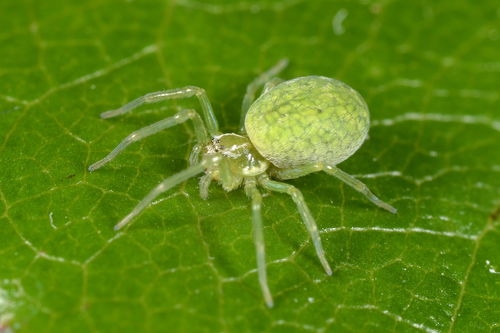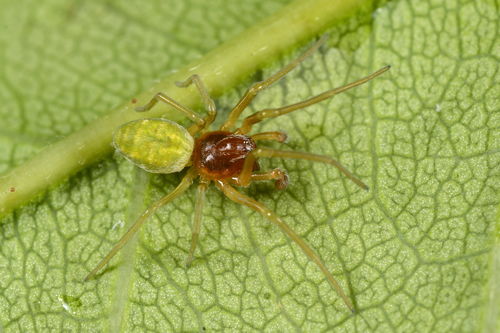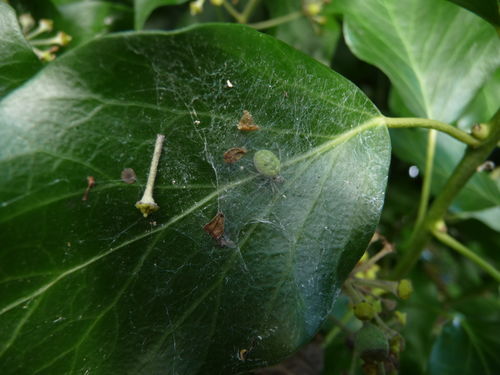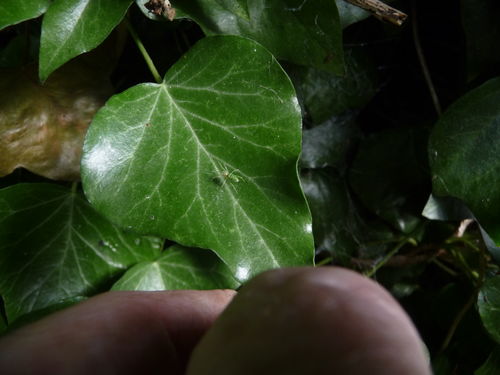Nigma walckenaeri (Roewer, 1951) (Araneae). An established spider in Worcestershire
John Bingham
Spiders are not my main area of interest unless they are either large and/or at least colourful, so when Denise Bingham found a 4mm long green spider in the garden it was at least colourful. The spider was distinctive, like a cucumber-spider Araniella cucurbitina, but slightly different and we appeared to have male and female present. I took some photographs (01, 02) and identified it as Nigma walchenaeri, but to be certain sent the images to Worcestershire spider expert John Partridge who kindly confirmed the identification.
The spider is an introduced species recorded in Britain at Box Hill and Kew (Surrey) as long ago as about 1880 and 1898 (Verdcourt 1997). It is now found mainly in the Thames valley and London and the Severn valley in Gloucestershire, Worcestershire and into Warwickshire. Apparently there are climatic similarities in these two area include average daily maximum and minimum temperatures in January and July. (British Spiders, Spider Recording Scheme). In 1993 it was first found in Worcestershire and it must had colonised all of the county to be here in Kidderminster, so check your gardens there is a good chance it will be there! Harry Green has a record for his garden but perhaps it was a little dubious with a link to an MBE (Partridge 2001). Other records are known from the county at Elmley Castle and elsewhere. In fact it is now as far north as Nottinghamshire with a record coming from the grounds of Worksop Priory in August 2013 (Pendleton 2014).
In our garden the spider was found on a leaf of Pieris 'forest flame' and Fremontodendron, Flannel Bush. According to the British Spiders web page adults are found in late summer on the leaves of bushes and trees in gardens and parks but also on scrub in more natural habitats. The spider spins a small web and retreat on the upper surface of leaves of bushes. The leaves of lilac, Forsythia, holly and ivy are especially favoured but any leaves are used with a similar size and curved surface across which the web can be made. Adults are generally found in late summer and autumn with females persisting into the winter. (information British Spider Recording Scheme).
Editor’s note
Nigma walchenaeri has been a regular in my garden in Little Comberton, near Pershore, as mentioned, for several years on ivy leaves and is there again this year (2013). Original identification by John Partridge. Spins flat webs on up-curved ivy leaves (03, 04) and has always been on same ivy clump to date. Harry Green
References and Reading
Partridge, J. 2001. Worcestershire Spiders. Worcestershire Record. 11:24-25, November 2001
Pendleton, T. & D. 2014. http://www.eakringbirds.com/eakringbirds3/arachnidsnigmawalckenaeri.htm
Verdcourt, B. 1997. Nigma walckenaeri (Roewer) (Arachnida, Araneae, Dictynidae) at Maidenhead, Berks, and at Kew, Surrey. Entomologists Monthly Magazine, 133:203.
Spider Recording Scheme. http://srs.britishspiders.org.uk/portal.php/p/Summary/s/Nigma+walckenaeri
Images
01 Nigma walckenaeri female. John Bingham.
02 Nigma walckenaeri male. John Bingham
03 Nigma walckenaeri on ivy leaf. Harry Green.
04 Nigma walckenaeri on ivy leaf.



